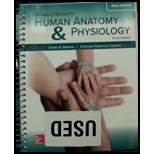
Pre-Lab Questions Select the correct answer for each of the following questions:
Muscles of mastication are all inserted on the
a. mandible.
b. maxilla
c. tongue.
d. teeth.
Introduction :
The oval cavity present in the skull is called the mouth. The mouth consists of various parts like lips, jaws, teeth, and vestibule. The teeth are located in the socket present in the jaw. The teeth are involved in splitting food into smaller parts. The zone between the lips, cheeks, and teeth is called the vestibule.
Answer to Problem 1PL
Correct answer :
The correct answer is option (a) mandible.
Explanation of Solution
Explanation/justification for the correct answer :
Option (a) mandible. The mastication muscles originated from the skull that ends in the mandibles. The mandible is present in the lower jaw. At the time of contraction, jaw movements are allowed by these mastication muscles. The muscles involved in the mastication are inserted in the mandible. So, the correct answer is an option (a).
Explanation for incorrect answer :
Option (b) maxilla. The maxilla is the fixed bone that is present in the upper jaw. The two maxillary bones fused together to form the fixed maxilla. The front of the mouth consists of the hard palate in the upper jaw. So, this is an incorrect option.
Option (c) tongue. The muscular organ of the mouth called tongue involves in the process of mastication and swallowing. It plays an important role in the digestive system and contains gustatory receptors. So, this is an incorrect answer.
Option (d) teeth. The layers pulp, dentin, cementum, and enamel together form the teeth. Teeth are not muscular in nature. The teeth do not contain muscles for mastication. So, this is an incorrect answer.
Want to see more full solutions like this?
Chapter 22 Solutions
Laboratory Manual For Human Anatomy & Physiology
Additional Science Textbook Solutions
Physics for Scientists and Engineers
College Physics: A Strategic Approach (3rd Edition)
Laboratory Manual For Human Anatomy & Physiology
SEELEY'S ANATOMY+PHYSIOLOGY
Biology: Life on Earth with Physiology (11th Edition)
Cosmic Perspective Fundamentals
- Identify the indicated cavity (Fucus). a. antheridia b. conceptacel c. receptacle d. oogonium e. none of thesearrow_forwardIdentify the indicated structure (Saprolegnia). a. antheridium O b. oospore c.sperm d. auxospore e. tetraspore Of. zygosporearrow_forwardUsing information from the primary literature (several references have been provided as a starting point below) please answer the following question: Based on your review of the literature on rewilding, what are the major scientific pros and cons for rewilding? Please note that the focus of this assignment are the (biological) scientific issues associated with rewilding. As will be discussed in class, there are a number of non-scientific issues involved or implicated in rewilding, all ultimately affecting the public acceptability of rewilding. Although these issues are important – indeed, critical – in this assignment you should focus on the biological science issues and questions. Details: You must enumerate at least two pros and at least two cons. Your answer should be no more than 500 well-chosen words, excluding references. Think carefully about how best to organize and structure your answer. Aim for high information density: say a lot, but say it succinctly. Recall Nietzche’s…arrow_forward
- Using information from the primary literature (several references have been provided as a starting point below) please answer the following question: Based on your review of the literature on rewilding, what are the major scientific pros and cons for rewilding? Please note that the focus of this assignment are the (biological) scientific issues associated with rewilding. As will be discussed in class, there are a number of non-scientific issues involved or implicated in rewilding, all ultimately affecting the public acceptability of rewilding. Although these issues are important – indeed, critical – in this assignment you should focus on the biological science issues and questions. Details: You must enumerate at least two pros and at least two cons. Your answer should be no more than 500 well-chosen words, excluding references. Think carefully about how best to organize and structure your answer. Aim for high information density: say a lot, but say it succinctly. Recall Nietzche’s…arrow_forwardNow draw a rough sketch of what the control data might look like if in addition to the specific binding, there was also a considerable amount of nonspecific binding (again using a normal dose/response curve) (do % total bound ligand vs concentration)arrow_forwardWhat are functions of cuboidal cells in the kidney? Select all that apply. Concentration of gases Dilution of chemicals Secretion of molecules Nutrition to tissues Support of tissues Absorption of moleculesarrow_forward
- question1 In plants, epithelial tissue is only found as the outermost cell layer and acts as a barrier. In humans, epithelial tissue is found inside the body as well as on the surface. What function(s) does/do epithelial tissue carry out in humans? Select all that apply. Waste storage Filtration Oxygen transport Protection Diffusion Osmosis Absorptionarrow_forwardWhat words best describes this organism? a. Unicellular/nonmotile Ob. unicellular/motile c. colonial/nonmotile d. colonial/motile e. multicelluar O f. siphonous g. none of thesearrow_forwardIdentify the phylum or class. a. Euglenophyta b. Dinoflagellata c. Bacillariophyceae d. Oomycetes e. Phaeophyceae O f. Myxomycota g. Xanthophyceae ○ h. Chrysophyceae i. Dictyosteliomycota O j. Rhodophyta Ok. Chlorophyceaens I. Charophyceaensarrow_forward
- Basic Clinical Lab Competencies for Respiratory C...NursingISBN:9781285244662Author:WhitePublisher:Cengage





